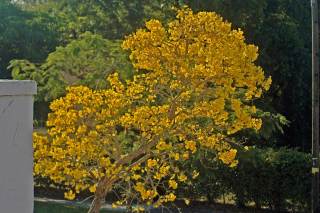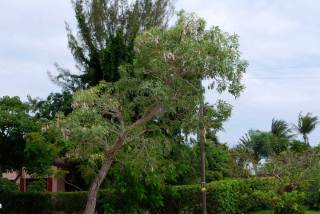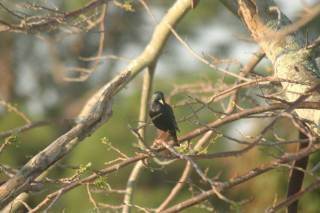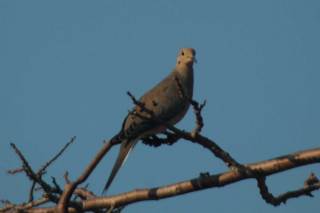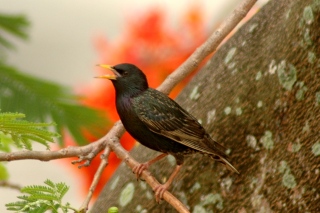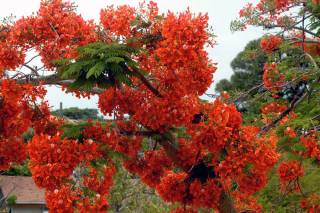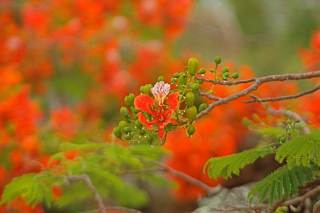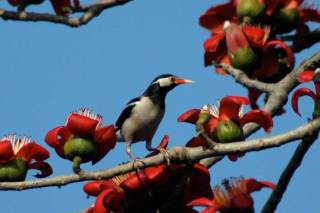Flowering trees add visual interest to your home landscape, sure. Some of them, like this Tabebuia tree (Tabebuia chrysotricha), that’s about all they do:
And they only do it for about three weeks a year. The picture above, taken in my front yard in late March, shows a beautiful yellow trumpet-flower tabebuia; today that tree looks a bit scraggly, with green leaves that remind me of a cross between a willow and an olive. I mean, it’s OK, but it’s nothing like its glory season:
Other trees, like the Royal Poinciana (Delonix regia), may look scraggly when they’re not in flower:
but even then they serve many different species of wildlife needs.
The pictures above were taken on the same day in late March as the tabebuia in all its glory, but this bare poinciana tree is playing host to several different bird species. And now in May, the starling in the top picture is nesting in one of the many cavities in this magnificent old tree. (Yes, I wish it were a more politically correct native species, like the Yellow-bellied Sapsucker I saw there earlier, or the Downy Woodpecker or Northern Cardinal I saw in it today while waiting for a decent shot at the starling, or even the Mourning Dove from March, but I guess it’s kind of appropriate: this non-native tree is hosting a non-native bird species!)
And you know what? I think the Royal Poinciana might be jealous of the Tabebuia stealing its thunder every year (the tabebuia flowers in March/April, the poinciania in May/June) because it is really pulling out all the flower stops now (Bijan Dehgan calls it “one of the most prized flowering trees in south Florida, and one of the most gorgeous trees in cultivation anywhere”):
D. regia is native to Madagascar (the generic name comes from Delos=conspicuous + onux=a claw, in reference to the long clawed petals; regia, regius means royal); T. chrysotricha is native to South America (it’s actually considered the national tree of Brazil; the generic name comes from the Brazilian native word for the tree, while chrysotricha means “with golden hairs”). Both trees do quite nicely here in South Florida, but I much prefer the poinciana, simply because I’ve seen so many more wildlife uses for it. That’s one of the reasons I’m not too keen on the beautiful exotic frangipani tree (Plumeria sp.) that are so common here: not only is it a non-native tree, but it doesn’t do a thing for the birds and insects I like to attract to my little corner of the world. I don’t want just pretty things; I want nectar sources for hummingbirds or beetles, pollen sources for bees. Sterile beauty is not something I will add to my landscape. I won’t root out the bougainvillea that was here when we moved in, but I won’t add to it. Anything I do add must combine the useful and the pleasant (dulce et utile, as Horace describes it in his letter to the Epistola ad Pisones, commonly known as Ars Poetica).
Starlings in other parts of the world seem to appreciate Horace’s advice, as well: On one of my trips to Delhi I saw this Asian Pied Starling (Sturnus contra) in a gloriously flowering kapok tree (Bombax ceiba, I believe):
A flamboyant flower for a flamboyant bird!
References
Dehgan, B. (1998). Landscape Plants for Subtropical Climates. Tallahassee: UP of Florida.

